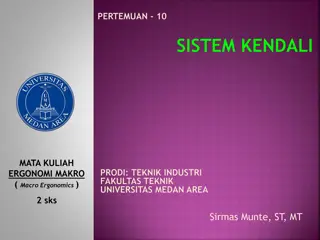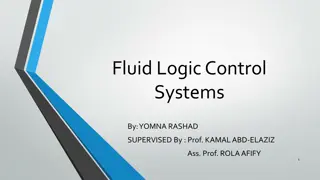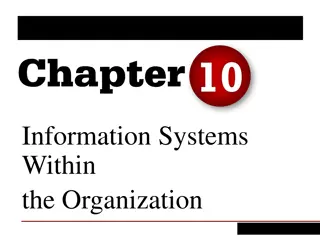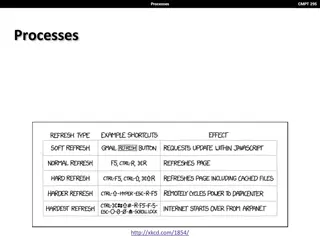Control Systems Basics
Dive into the foundation of process control with a focus on system representation, including mathematical and graphical approaches. Explore essential concepts such as differential equations, transfer functions, and state space equations in analyzing mechanical-electrical systems. Understand the key steps for modeling translational mechanical systems and the general procedure for addressing forces and motions in mechanical systems.
Download Presentation

Please find below an Image/Link to download the presentation.
The content on the website is provided AS IS for your information and personal use only. It may not be sold, licensed, or shared on other websites without obtaining consent from the author.If you encounter any issues during the download, it is possible that the publisher has removed the file from their server.
You are allowed to download the files provided on this website for personal or commercial use, subject to the condition that they are used lawfully. All files are the property of their respective owners.
The content on the website is provided AS IS for your information and personal use only. It may not be sold, licensed, or shared on other websites without obtaining consent from the author.
E N D
Presentation Transcript
- Control In Processes and Systems Dr. Enas Ismail E-mail: enas.ismail@mu.edu.eg - 2020
PROCESS UNDERSTANDING The Foundation of process control is Process Understanding
System Representation 1. System Representation (Mathematically) (Differential Equations of a system) (Transfer function of A system) (Modeling of some Analogous Systems) (Mechanical-Electrical) (State Space Equations) 2. System Representation (Graphically) (Block Diagram & Block Diagram Reduction) (Signal Flow Graph)
System Representation 1. System Representation (Mathematically) Differential Equations (DEs) Transfer Function (TF) State Space Equations (SS) Models derived from basic physical laws that describe the process. - Ohm s law, Kirchoff s law - Newton s law TF=Laplace Transform(system output)/Laplace Transform (system input) under assumption all initial conditions equal zero. SS transforms n th order differential equation into n set of first order differential equations. System Analysis requires transformation of DEs into TF. It introduces state variable/s that could be used to define any entity within the system that sometimes is not possible to measure but affects the system.
System Representation Mathematically-Differential Equations (Modeling of some Analogous Systems) (Translational Mechanical-Electrical)
Translational Mechanical System (1) Mechanical System ?(?) = ?? = ? ?(?)?? f ? = ??(?) ?(?) = ??? ?? f(t)= ? ?(?) f(t)= ???(?) ??
Translational Mechanical System (2) The general procedure for mechanical systems is as follows i. Adopt a suitable co-ordinate system with an appropriate sign convention. For linear motion, up is positive and left to right is positive. ii. Identify any disturbing forces acting on the system (inputs to the system). iii. Identify displacements and/or velocities (outputs from the system). iv. Draw a free body diagram for each mass showing all the forces and moments acting on it. v. Apply Newton's 2nd Law to each free body diagram (F = Mass x Acceleration). vi. Rearrange the equation(s) into a suitable form for solution by a convenient method. vii. Note that unless otherwise specified, ignore gravitational effects.
Example 1: Translational Mechanical System Example-1: Consider a simple horizontal spring-mass system on a frictionless surface, as shown in figure below. = m x kx or + kx = m x 0 13
Example 2: Translational Mechanical System Consider the following system (friction is negligible) k x M F Free Body Diagram k f f M M F Where and are force applied by the spring and inertial force respectively. f k f M 14
Example 2: Translational Mechanical System k f f M M F = + F f f k M Then the differential equation of the system is: = + F M x kx Taking the Laplace Transform of both sides and ignoring initial conditions we get 2 = + ( ) ( ) ( ) F s Ms X s kX s 15
Example 2: Translational Mechanical System 2 = + ( ) ( ) ( ) F s Ms X s kX s The transfer function of the system is ( ) X s 1 = ( ) 2 F s + Ms k if = M kg 1000 1 = k Nm 2000 ( ) . X s 0 s 001 2+ = ( ) F s 2 16
Example 3: Translational Mechanical System Consider the following system k x M F C Free Body Diagram k f f C M f F M = + + F f f f k M C 19
Example 3: Translational Mechanical System Differential equation of the system is: = + + F M x C x kx Taking the Laplace Transform of both sides and ignoring Initial conditions we get 2 = + + ( ) ( ) ( ) ( ) F s Ms X s CsX s kX s ( ) X s 1 = ( ) 2 F s + + Ms Cs k 20
f(t) - kx - bx' - mx" = 0 Taking the Laplace Transform of the governing equation results in: F(s) - k[X(s)] - b[sX(s)] - m[s2X(s)] = 0 Collecting all the terms involving X(s) and factoring leads to: [ms2 + bs + k] X(s) = F(s) 22
Transfer Function The transfer function is defined as the output Laplace Transform over the input Laplace Transform, and so the transfer function of this second order system is: X(s)/F(s) = 1/[ms2 + bs + k] COMMAND: transferfunction = tf(num, den) 23
Input X(s)/F(s) = 1/[ms2 + bs + k] into MATLAB: Let m = 2, b = 5, and k = 3. >> m = 2; >> b = 5; >> k = 3; >> num = [ 1 ]; >> den = [ m b k ]; >> tutorial_tf = tf(num, den) Transfer function: 1 --------------- 2 s^2 + 5 s + 3 24
Example (4) Solution
Electrical System (1) Electrical system ? ? = ?? ? ? ? =1 ?? ? ? ? =1 ? ? ? ?? ? ? = ???(?) ?? ? ? = ???(?) ?? ? ? =1 ? ? ? ??


